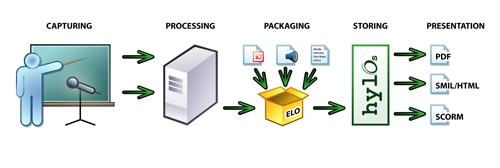Content Acquisition
A manual preparation of eLearning objects remains a tedious
undertaking, no matter how well it is supported by appropriate tools.
In addition, most presentation material currently in use is brought to
lecture rooms by notebooks or offline media, not compliant to the LOM /
IMS packaging standard.
This solution adds an automatic content acquisistion subsystem to
hylOs, which will produce eLOs 'out of the lecture room'. Complying to
a predefined quality standard, these objects may then be used for rapid
playout or manual refinement.
Audiovisual streams are available for capturing within modern equipped lecture halls. We concentrate on visual presentation material in combination with spoken audio. These signals, images and audio streams, are continuously captured and segmented, triggered by a change of slide or presentation material. After segmentation the appropriately encoded media will be packaged and annotated with technical metadata stored as raw eLOs within hylOs as shown.
Subsequent post processing will assign keywords and a classification from a predefined taxonomy to the newly acquired objects. As little textual material is available, pure statistical techniques for extracting keywords cannot be used. Instead we employ a controlled vocabulary for keyword spotting. A selection of several thousand preclassified technical terms is searched within the text and audio files. We further proceed in a dictionary based approach to derive the classification indices of the object by using our previously statistically classified keyword set. Current classification is done with respect to DDC and ACM CCS. Speech recognition is done using the Philips Speech SDK.
Currently available preliminary results indicate that calculation efforts remain close to real-time. By analyzing text and speech content the recorded eLearning objects can thus be enriched by a title, the author, keywords and classification categories.

